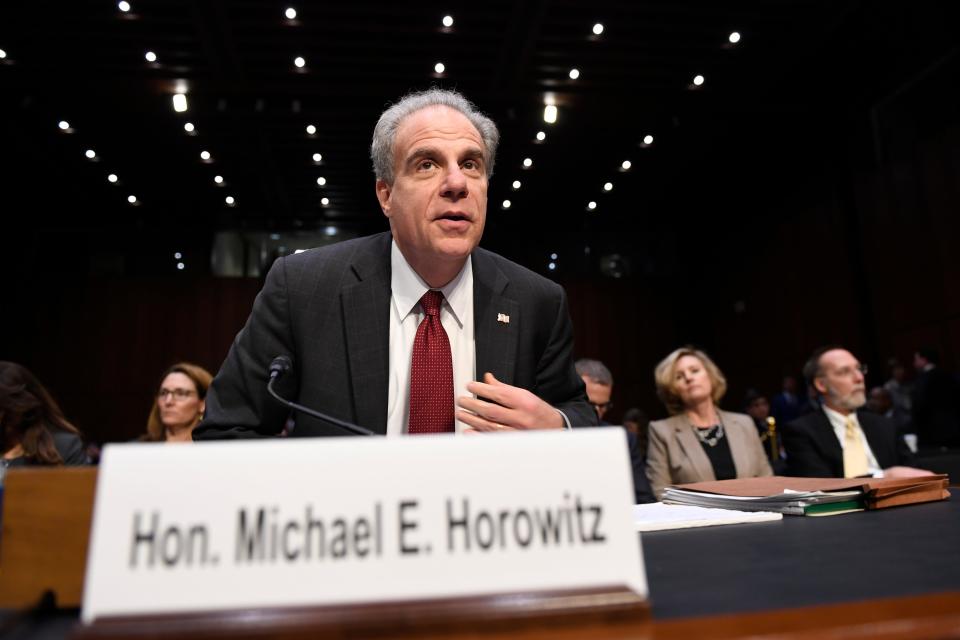Inspector General report: Department of Justice needs 'consistent approach' to body cameras
Despite having spent millions of dollars bolstering local law enforcement body camera programs, a report released Thursday by the Justice Department’s Office of the Inspector General says that many Department of Justice agencies are “generally unprepared” to implement body camera programs of their own.
“For the past decade, the DOJ has studied, supported and promoted the use of body-worn cameras by state, local and tribal law enforcement agencies...,” Inspector General Michael E. Horowitz said in a video released with the report. "...Nevertheless, our review found that DOJ law enforcement officers themselves largely did not use body-worn cameras."

Body camera use is commonplace in local police departments. The Department of Justice has provided state, local and tribal law enforcement with over $115 million to better their body camera programs, according to the report. But prioritizing the camera use among federal officers is a significant shift.
According to the report, the use of body-worn cameras on operations was not typically allowed by the Department of Justice until October 2019, even if they were partnering with law enforcement officers who did have body camera programs. A year later, the Department officially authorized their own task force officers to use cameras on some operations, but they still did not usually own or use the cameras, the report reads.
Policies recently requested by the deputy attorney general aim to remedy that.
More: Police body cameras can be valuable, but due process is key: Fraternal Order of Police
On June 7, the Justice Department announced it would require federal officers to wear body cameras when making planned arrests or issuing search warrants.
The directive, issued by Deputy Attorney General Lisa Monaco, was sent to the heads of the FBI, the Drug Enforcement Administration, the U.S. Marshals Service and the Bureau of Alcohol, Tobacco, Firearms and Explosives. It further required those agencies to develop policies for body camera use within 30 days.
The inspector general noted the recently required body camera policies were not included in Thursday's report, as their development is ongoing.
The report identified three main areas of concern: policies for body worn camera use, operational costs of a body camera program and contracting options for the purchase of body camera equipment and management systems.
The Inspector General’s office suggested the Justice Department consider camera activation and deactivation requirements, video retention requirements, privacy concerns and creating policy to guide the release of camera footage to the public.
According to the report, the DOJ agreed with all of the Inspector General’s recommendations regarding those concerns.
The audit that produced Thursday’s report was initiated in June 2020. It cites the police killing of George Floyd, which occurred on May 25 of that year, as a reason that increased use of body cameras can be effective.
“In the past decade, use-of-force events involving law enforcement officers (LEOs) have led to increased calls from legislators and the public to expand the use of body worn cameras (BWCs),” the report reads. “...(Body worn camera) programs have benefits for both LEOs and the public, in that they can hold LEOs accountable for wrongdoing as well as protect those LEOs against false accusations.”
More: George Floyd anniversary: Release police body camera videos of deadly arrests
After Floyd’s death, the George Floyd Justice in Policing Act of 2020, which aims to bolster police accountability and includes increased use of body worn cameras, was introduced in the House. It did not receive a vote in the Senate and was reintroduced in March. It passed the House on March 3.
Video evidence of Floyd's killing taken by teenage onlooker Darnella Frazier was key evidence in the murder trial of the offending officer, Derek Chauvin. Frazier was awarded a special citation by the Pulitzer Board for "courageously recording the murder of George Floyd, a video that spurred protests against police brutality around the world, highlighting the crucial role of citizens in journalists' quest for truth and justice."
More: Darnella Frazier, teen who recorded George Floyd's murder, reflects on his death a year later
While the George Floyd bill has not yet been voted on by the Senate, the Inspector General report indicated that divisions of the Justice Department did not intend to implement body camera programs without direction from the Department, “stressing the need for guidance and funding that would establish a consistent approach to program implementation across the Department,” the report reads.
“A consistent approach would help to ensure that a BWC program would assist federal prosecution efforts, as well as the efforts of the many state and local law enforcement agencies with whom the Components collaborate,” the report reads.
This article originally appeared on USA TODAY: Inspector General: DOJ needs 'consistent approach' to body cameras

